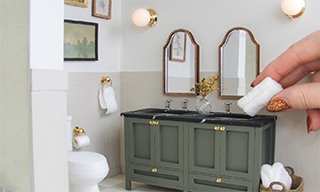by Fran Casselman

Materials:
#6022 Houseworks Single French Door
1/32" thick x 2 1/16"W x approx. 4 3/8"L, Basswood sheet
3/8" x 3/32" Basswood strip wood
3/8" x 1/32" Basswood strip wood
1/32" x 3/32" Basswood strip wood
#1114 Houseworks Knob & Key Plate with Key
#82131 Plasticutter or sharp knife
#10115 12" Stainless Steel Ruler
White glue
Wood filler
Stain and paint of choice.
Note: Basswood was used to ensure consistent color for a stained door. If the door will be painted, the wood pieces can be of any variety and the panel can even be of smooth cardboard, if desired.
Remove door slab from frame (the door is pinned top and bottom through the frame and can usually be removed by pulling out one pin). Remove the door’s acrylic panel and wood grid.
If your door will be stained, stain all the pieces now, before final cutting and assembly. If it will be painted, paint it after assembly.
Determine the height of the 1/32" wood panel. This is somewhat arbitrary and can be whatever you think looks best. Mine was about 4 3/8". Remember that part of the height will be hidden by the frame and the rail. Cut the panel to length and slide it into the door in place of the acrylic panel. Slide the acrylic panel in on top of the wood panel, and mark it at the top of the door. Cut the acrylic panel slightly shorter than the mark.
(To cut the acrylic, score the line you want to cut using a ruler and a sharp knife or #82131 Plasticutter. Do not try to cut this line, just score it firmly in one pass. Then, hold the panel down flat with the score on the sharp edge of a table or block of wood. Press the free end down and it should snap cleanly on the score line.)
To assemble, slide the wood panel in place, followed by the acrylic. The rail covers the line where the wood and acrylic meet. It should be 1 13/16" long, but small variances are possible so cut yours to the precise measurement of your door. Cut another for the back of the door.
Glue the front rail in place. Try not to adhere it to the acrylic, so it can be removable if you want to add stained “glass” or try another look later. The rail should be flush with the surface of the door. Make sure it is square and allow to dry. Repeat with the back rail. Remove the acrylic panel.
The stile divides the bottom section of the door vertically into two panels. Cut front and back pieces to length for your door, center and glue in place. It should be inset, not flush with the surface of the door.
The light (window) at the top of the door can be divided in almost any configuration you choose, or not at all. It can have a stained glass or leaded glass panel; the choice is yours. Research images of Craftsman doors online or in print materials to find a look you like.
For the simple look I chose, cut two pieces of 1/32" x 3/32" wood to the height of the opening and glue them in place, dividing the light into thirds, with the wider side exposed. The stiles should not be flush with the surface of the door. Note: The acrylic panel was not in place for this step, so the strips are glued at the top and bottom only. I did not add stiles on the back side of the door.
The #6022 door comes with a grooved casing, which was not the look I wanted. I filled the grooves with wood filler, then sanded and painted for a smooth look. Reinstall door in frame.
For hardware, I used #1114 Houseworks Classic Key Plate and Knob, installed upside down from the usual way. For the look of a deadbolt lock, I glued a 3mm round punched from a scrap of Styrene (cardboard would be fine) near the (now) top of the key plate and painted it all with bronze-colored nail polish.
I stained my door (in pieces, prior to assembly) with brown Kiwi Color Shine shoe polish. I sealed the assembled door and painted frame with one coat of satin varnish by Delta.



